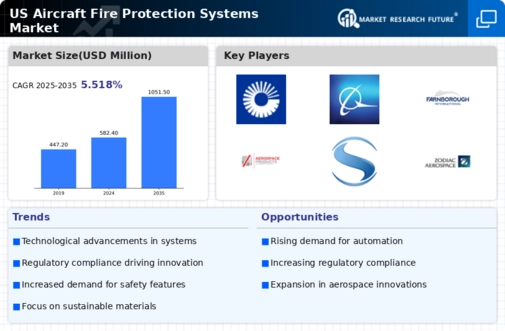The US Aircraft Fire Protection Systems Market is characterized by a dynamic environment driven by technological advancements and regulatory compliance aimed at ensuring aviation safety. This market comprises various players focusing on developing innovative fire protection solutions to meet the competitive demands of the aerospace sector. As air travel continues to expand, the importance of robust fire protection measures to prevent and address potential hazards in aircraft becomes paramount.
The competitive landscape involves established companies and emerging startups, all striving to enhance their product offerings through research and development, strategic partnerships, and a keen approach towards meeting the increasing safety standards mandated by regulatory authorities. The interplay of innovation, compliance, and customer needs shapes a continually evolving market where effective fire protection solutions are pivotal for operational efficiency and safety assurance.Raytheon Technologies is a key player in the US Aircraft Fire Protection Systems Market, leveraging its extensive expertise in technology and defense systems.
The company benefits from a strong presence in the aerospace sector, offering a diverse portfolio that includes advanced fire detection and suppression systems tailored for various aircraft types. Raytheon Technologies integrates cutting-edge technology into its offerings, which enhances their effectiveness in preventing and mitigating fire hazards during flight operations. The company’s solid research foundations and commitment to innovation position it favorably in the competitive landscape, allowing it to respond to the evolving demands of the market while ensuring compliance with stringent safety regulations.
Raytheon Technologies has developed robust relationships with both commercial and government stakeholders, showcasing its reliability in delivering top-tier fire protection systems across the US aviation ecosystem.UTC Aerospace Systems, recognized as a significant entity in the US Aircraft Fire Protection Systems Market, brings a wealth of experience and a focused approach to aircraft safety solutions. The company is well-known for its comprehensive range of products, including fire detection systems, suppression systems, and thermal management technologies essential for ensuring aircraft safety. UTC Aerospace Systems leverages its strong reputation and technological prowess to meet the specific fire protection requirements of the aerospace industry.
The company continually invests in research and product development, enhancing its capabilities to provide state-of-the-art safety solutions. Moreover, strategically important mergers and acquisitions have bolstered UTC Aerospace Systems’ market position, allowing it to expand its product lineup and enhance service offerings tailored for the US market. The company’s strengths lie in its innovative approach and commitment to quality, ensuring it meets the highest standards in fire protection for the aviation sector.



















